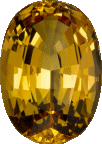| |
Topaz
|
Topaz receives its name from the Isle of Topazos, which is the historical name for the island of Zabargad off the coast of Egypt. This has caused some conflation as the name topazius was historically applied to the modern peridot. The historical name for the modern topaz was chrysolite or Oriental Topaz.
This conversion of taxonomy, along with the visual similarity of the various topazes to other gems, has caused the folkloric properties of the stone to be a bit muddled. Though often confused with beryl, modern topaz is an aluminosilicate completely lacking beryllium. Due to visual similarities blue varieties of topaz are still often misidentified as the more expensive aquamarine.
This is farther complicated as the most common color of natural topaz is not blue, but yellow or clear. Most of the familiar blue topaz on the market today is actually irradiated white topaz. Because of the similarity in appearance early lapidaries will sometimes classify topaz as a citrine or quartz. This was done in spite of the greater hardness of the topaz, which was attributed to the topaz being of a greater quality than the softer quartz. Eventually the word topaz came to be applied to all translucent yellow stones, with our modern topaz being classified as the “oriental” variety.
Some of the lapidaries believed that Topaz was a charm against pestilence and bad vapors, and that it would make travelers well received by nobles and other dignitaries. However, some of the more interesting folklore involves the reported ability of the topaz to cool things down. Many early lapidaries claimed that if one were to throw a topaz into a kettle of boiling water, it would deprive it of heat and stop it from boiling. It was similarly imbued with the ability to break fevers, cool tempers, and prevent lechery.
This may well be due to the density of the topaz compared to similar looking materials, not only does the topaz tend to be heaver but it also makes it less able to pick up radiant heat. This causes the stone to fell much cooler than other stones.
|
Colors
|
Clear, Yellow, Blue, Red
|
Locations
|
Africa, Brazil, China, Mexico, Pakistan, Russia, and the USA
|
Compisition
|
Al2(F, OH)2SiO4
|
Hardness
|
8
|
|

|

|

|
|
|
|
|
|